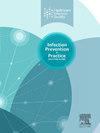A decade of epidemiology and incidence of carbapenemase-producing bacteria in a tertiary hospital in southern Europe
IF 1.9
Q3 INFECTIOUS DISEASES
引用次数: 0
Abstract
Background
Carbapenemase-producing Enterobacterales (CPE) are a growing issue that healthcare systems all over the world are facing and which have been producing clinical cases for >20 years, with a spike in incidence in the last decade. In the Universitary Hospital of La Paz (HULP), the first CPE outbreak occurred in 2011 and incidence has been variable since then.
Aim
To conduct an epidemiological analysis of the distribution and microbiological characteristics of the four main types of carbapenemases (OXA-48, VIM, KPC, and NDM) obtained from bacteria isolated in the HULP, a tertiary hospital north of the city of Madrid, between 2012 and 2022.
Methods
An observational retrospective analysis was performed to attain the incidence characteristics of CPE and their associated outbreaks. The study used data from 5723 individual cases for which the sex and age of the patient, type of sample, isolated bacteria, type of carbapenemase, type of case (infection or colonization) and where and when the isolate was obtained.
Results
Since the first outbreak of CPE was detected in 2011, contain-and-response protocols were put in place to avoid the spread of CPE within the hospital setting.
Conclusion
The implementation of CPE infection preventention and control guidance since 2013 and (in 2022) updated protocols has impacted the number of cases, but further incidence studies should be conducted to analyse the effectiveness of these measures and assess the patterns of carbapenemase genes over time.
欧洲南部某三级医院碳青霉烯酶产菌的流行病学和发病率研究
产碳青霉烯酶肠杆菌(CPE)是世界各地卫生保健系统面临的一个日益严重的问题,并且已经产生了20年的临床病例,在过去十年中发病率激增。在拉巴斯大学医院(HULP),第一次CPE暴发发生在2011年,此后发病率一直在变化。目的对2012年至2022年在马德里市北部的一家三级医院HULP分离的细菌中获得的四种主要类型碳青霉烯酶(OXA-48、VIM、KPC和NDM)的分布和微生物学特征进行流行病学分析。方法采用观察性回顾性分析,了解CPE的发病特点及其相关暴发。该研究使用了来自5723例个体病例的数据,其中包括患者的性别和年龄、样本类型、分离的细菌、碳青霉烯酶类型、病例类型(感染或定植)以及获得分离物的地点和时间。结果自2011年首次发现CPE暴发以来,制定了控制和应对方案,以避免CPE在医院环境中传播。结论自2013年以来实施的CPE感染防控指南和(2022年)更新的方案对病例数量产生了影响,但应开展进一步的发病率研究,以分析这些措施的有效性,并评估碳青霉烯酶基因随时间的变化模式。
本文章由计算机程序翻译,如有差异,请以英文原文为准。
求助全文
约1分钟内获得全文
求助全文
来源期刊

Infection Prevention in Practice
Medicine-Public Health, Environmental and Occupational Health
CiteScore
4.80
自引率
0.00%
发文量
58
审稿时长
61 days
 求助内容:
求助内容: 应助结果提醒方式:
应助结果提醒方式:


